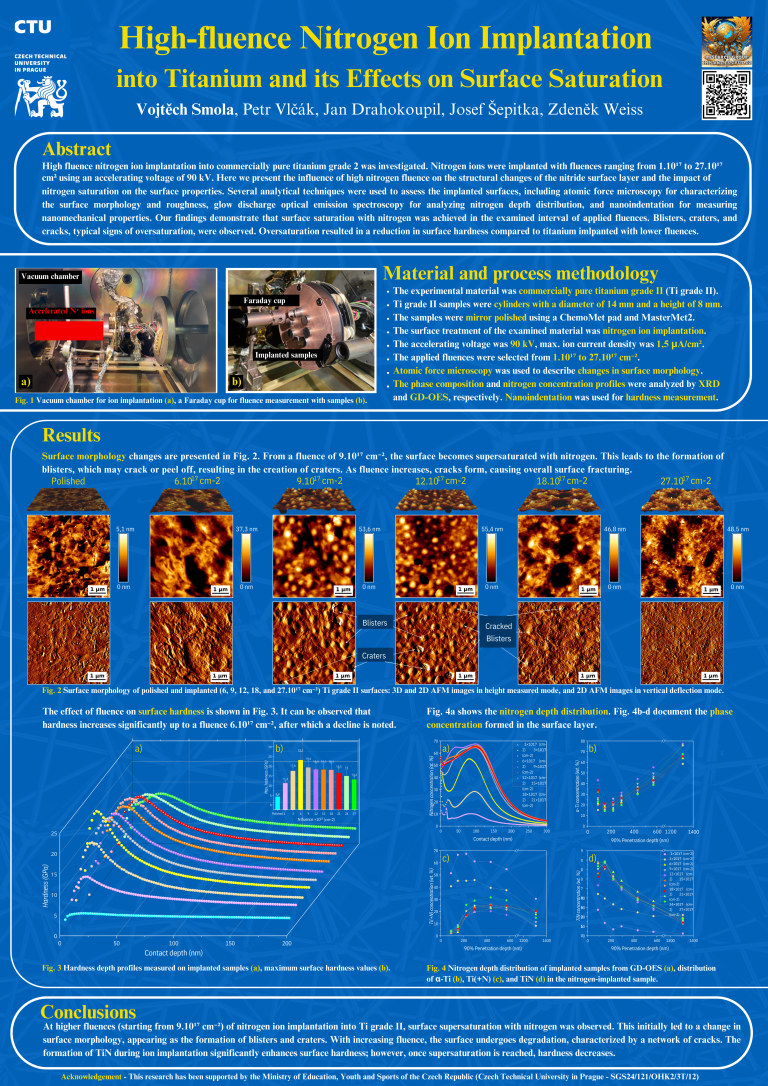High-fluence Nitrogen Ion Implantation into Titanium and its Effects on Surface Saturation

V. Smola, P. Vlčák, J. Drahokoupil, J. Šepitka, Z. Weiss
Future Materials Athens 2024
ABSTRACT
High fluence nitrogen ion implantation into commercially pure titanium grade 2 was investigated. Nitrogen ions were implanted with fluences ranging from 1.10¹⁷ to 27.10¹⁷
cm⁻² using an accelerating voltage of 90 kV. Here we present the influence of high nitrogen fluence on the structural changes of the nitride surface layer and the impact of
nitrogen saturation on the surface properties. Several analytical techniques were used to assess the implanted surfaces, including atomic force microscopy for characterizing
the surface morphology and roughness, glow discharge optical emission spectroscopy for analyzing nitrogen depth distribution, and nanoindentation for measuring
nanomechanical properties. Our findings demonstrate that surface saturation with nitrogen was achieved in the examined interval of applied fluences. Blisters, craters, and
cracks, typical signs of oversaturation, were observed. Oversaturation resulted in a reduction in surface hardness compared to titanium imlpanted with lower fluences.
MOLECULAR DYNAMICS SIMULATION OF THE DIFFUSION BEHAVIOUR IN Ti-Ag

Š. SVOBODA, M. LEBEDA, P. VLČÁK, J. DRAHOKOUPIL
Nanocon 2023
ABSTRACT
Ti-Ag alloy system is interesting for its biocompatibility and bioadhesion properties, therefore it is promising for the production of bone implants. Classical molecular dynamics was used to simulate diffusion in the Ti-Ag system. It is very suitable for this purpose. It provides the positions of the atoms at each time step, from which it is possible to obtain the mean square displacement, which can be used to easily calculate the diffusion coefficient. The disadvantage, however, is the huge computational complexity and so we have to limit ourselves to a
very small number of atoms (in this work only about 100,000) and very short time intervals (in this case only 6 ns)
ATOMISTIC SIMULATIONS OF ION IMPLANTATION: THE SPUTTERING EFFECT ON DEPTH DISTRIBUTIONS

M. Lebeda, J. Drahokoupil, P. Vlčák
Nanocon 2023
ABSTRACT
Within the domain of molecular dynamics simulations investigating the ion implantation phenomena, the precise incorporation of the sputtering effect is important for accurate predictions of surface properties and the spatial distribution of implanted particles throughout the target material. However, this becomes computationally demanding task, especially for middle-to-high fluences, owing to the substantial number of atoms required for such simulations. In this study, a novel approach was introduced to address this issue. Sputtering effects based on yield data from the Monte Carlo TRIDYN software were integrated into the molecular dynamics simulations using an in-house algorithm implemented within the LAMMPS code. This integration significantly reduces the computational time, allowing for efficient simulations. The practicality of this algorithm is demonstrated by its application in predicting depth distributions of N particles implanted within an α-Ti target as a function of N fluence. The simulation results with and without the inclusion of the sputtering are compared, and validated with established TRIDYN simulations and experimental data obtained via GD-OES. This work showcases an efficient and pertinent approach for predicting high-dose ion implantation effects.
MOLECULAR DYNAMICS SIMULATIONS OF NITROGEN ION CHANNELING IN α-TITANIUM TARGET

M. Lebeda, J. Drahokoupil, P. Vlčák
Nanocon 2022
ABSTRACT
Implanting N ions into Ti-based materials improves their
properties such as hardness, corrosion resistance, or friction
coefficient. During the implantation, significant number of ions can be guided through crystal channels, resulting into larger
penetration depths (i.e., ion channeling) and smaller number of
crystal defects. An important characteristic of ion-implanted
materials is ion distribution across the depth of the target.
Depending on the parameters of implantation, depth distributions can be strongly affected by the channeling effect. In this work, we used molecular dynamics (MD) simulations to predict the N ion channeling in hex. α-Ti at 0.5-4 keV kinetic energies, different surface orientations, target temperature, and incident angle.
ATOMISTIC SIMULATION OF NITROGEN ION IMPLANTATION INTO α-TITANIUM TARGET

M. Lebeda, Z. Weiss, J. Lorinčík, I. Elantyev, P. Veřtát, J. Drahokoupil, P. Vlčák
Nanocon 2021
ABSTRACT
Implantation of nitrogen particles into titanium target changes (improves) its hardness and tribological properties in the depth ranging from a few up to hundreds of nanometers. In order to understand how these properties are influenced, it is important to determine the N concentration across the depth of the modified target. However, different experimental methods determining atomic distributions are subjected to various instrumental errors and samples imperfections. To obtain expected atomic distributions without such errors, computer simulations are being advantageously used. In this work, using atomistic molecular dynamics (MD) method and our self-implemented time saving algorithm for ion implantation, we predict N depth distributions and their characteristics in α-Ti as a function of N fluences. The MD data are compared with TRIM and with experimental profiles obtained by SIMS and GD-OES. We confirm that the MD distributions improve TRIM predictions, have in general good correspondence with the experiments, and suggest expected distributions for an ideal implantation situation.
AB-INITIO STUDY OF SURFACE ENERGIES AND STRUCTURAL INFLUENCE OF VACANCIES IN TITANIUM NITRIDE NANOLAYER

M. Lebeda, P. Vlčák, J. Drahokoupil
Nanocon 2020
ABSTRACT
Titanium nitride (TiN) is largely applied as protective nanolayer of medical titanium implants due to its significant positive influence on the surface properties such as friction and corrosion resistance. During the process of its phase formation, occurrence of the point defects is probable and can potentially affect various material properties, e.g. change the lattice parameters. The surface energies of 8 crystallographic planes and effects of nitrogen vacancies on the lattice parameter in rock salt-like structure of TiN (δ-TiN) were studied using ab-initio method of density functional theory (DFT) with the generalized gradient approximation functional (GGA) as parametrized by Perdew, Burke and Ernzerhof (PBE). TiN supercell with 64 atomic positions was used for the calculation of defects influence and the results are thoroughly discussed in the context of available theoretical and experimental literature data. The linear decrease of lattice parameter with the increasing presence of nitrogen vacancies up to ca. 80 % was observed.The surface energy of (100) crystallographic plane is two times lower (1.499 J/m2) than for the rest of the studied planes.
